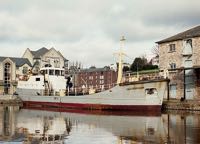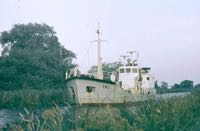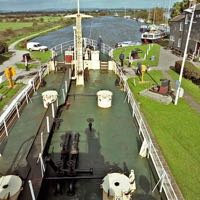
MV Countess Wear or MV SW2
Exeter’s sludge boat
Page added 28th May 2017
Back to Transport
The last ship to use the Exeter Ship Canal was the sludge boat, Countess Wear. This little ship could be often seen moored in the Lime Kiln Basin, just below the Countess Wear swing bridge, or if you were lucky, traversing the canal, on its way to or from dumping a load of sludge in the English Channel.
When the sewage works opened 1931 on a marsh between the canal and the river, the effluent was discharged directly into the river. The growth of the city after the Second War increased the amount of effluent discharged and it became apparent that the river flow could no longer take the increased quantity of effluent. Along with discharges from the River Creedy and from Topsham, the Exe Estuary was becoming a hazard to health by 1949.
Dump at sea
In the early 1960s, the city council, who were then responsible for the sewage works, decided to have a ‘waste disposal vessel’ built. Bolson and Son of Poole were approached to build the ship, which was launched in 1963. The vessel was named SW2, as she was considered to be a vehicle belonging to the sewage works, and the name SW1 had already been given to a blue Morris van used by workmen to travel between the Council service depot at Tan Lane and a pumping station in Western Road off Okehampton Street.
SW2 had a gross tonnage of 237 tons and a DWT of 366 tons—this is the maximum weight the ship can carry, not including the weight of the ship. One can imagine how that can drift about and pollute local beaches, and upset the balance of the ecology of the sea. She was built to the maximum size that could fit the canal, while, even with the speed limit in the canal, she could leave Turf Lock at high tide, sail out and dump her load, in time for the next high tide to re-enter the lock.
Captain Long was appointed to skipper the ship, while her ship’s mate Mr Gardner would skipper her as the MV Countess Wear on her last voyage. The council had conducted tests a couple of years before she was commissioned at dumping sludge out to sea, and measuring where it drifted in the Channel. The test seemed to confirm that the sewage dispersed safely, but when the SW2 started dumping sledge it unfortunately ended up on Teignmouth beach.
SW2 was renamed MV Countess Wear in 1974. When the new M5 motorway bridge was constructed over the river and canal in 1975, it was found that the Countess Wear was too tall to pass under. The ships mast was slightly shortened to allow her to pass under the bridge. Exeter She was transferred to the newly privatised South West Water in 1989.
In 1979, the Countess Wear, now skippered by Ron Gardner, was at her approved dumping area, eight and a half miles out in the Channel, when a couple of lads were seen drifting in a small glass fibre dingy. Skipper Gardner took up the story.
"It was about a quarter to eleven on the Monday morning and we had just started to discharge hour cargo when we noticed the two youngsters in trouble. It proved very difficult to get alongside them as there was a Force 6 Northwesterly gale blowing and we had to be really careful not to knock into them.
We managed to master the elements and position ourselves so that we could pick them up. I can tell you they were more than glad to see us. They had been stranded since midnight in a night of howling wind.
They were blue and I doubt if they would have lasted too much longer, if we had not picked them up.They were very cold and wet and so grateful for the blankets and soup we provided.They were very lucky and realised it."
Last voyage
In 1989, the old sewage works and the Countess Wear, became part of the newly privatised South West Water. Dumping sludge at sea came to the end after European legislation banned the practice, due to the pollution of beaches and waterways. In April 1997, South West Water announced that they were going to retire the Countess Wear. Her last trip to dump waste at sea was on December 31, 1998. Her Captain, Ron Gardner, 63, and his two-man crew navigated her along the old canal to Turf Lock. At high tide, the locks opened and she sailed into the Exe Estuary, and out into the Channel. At nine miles out, her tanks were opened into an area specified by the Ministry of Agriculture. This was the last of more than 5,000, six hour round trips taken since her first voyage in 1963.
Her last trip up the canal was in January 1999, when she made a ceremonial visit to the basin,. She was put up for sale and, one report states, she went to Canada, while another states she ended up in the West Indies or Guyana delivering fresh water in her stainless steel tanks.
Sources: Memories of Steve Garry whose father was chief chemist at the works. Express and Echo. A post in rmweb.co.uk, SWW staff magazine.
│ Top of Page │





